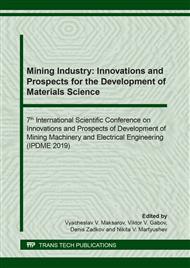p.1
p.6
p.13
p.19
p.25
p.36
p.41
p.46
Investigation of Low Rotational Speeds Effect during Centrifugal Casting on the Mechanical Properties of Polymer Composites Material
Abstract:
In this article, we present our developed and manufactured centrifugal casting machine. We present the results of mechanical testing of samples from polymer composites made on it. At the beginning we give an overview of the main trends in the market of polymer composites. We consider the main factors affecting the mechanical characteristics of polymer composites, and determine the main limitations of using centrifugal casting technology for polymer composites. In conclusion, we give directions for further research. Many industries use polymer composite materials (PMC) to meet production needs. The main advantage of PMC is the possibility of obtaining high strength with relatively low weight, as well as the possibility of obtaining additional necessary properties, such as dielectric, magnetic, etc. The PMC market continues to grow, and now PMC is widely used in aircraft manufacturing, automotive, medicine, etc. [1]. Despite the positive aspects of using PMC, this method has some drawbacks. Firstly, low automation of the process of casting parts from PMC. Many technologies are quite difficult to automate due to their process complexity and constant monitoring. Development in this direction is already underway, and there are practical solutions, such as automatic tape placement (ATL) / automatic fiber placement (AFP) [2]. On the other hand, the cost of these solutions is quite high. Secondly, the high cost of the equipment and tooling manufacturing. Such technologies as pressing, pressing and autoclave molding using prepregs are attached to certain technological equipment and need to organize pressure, maintain temperature, etc. This increases the range of equipment used and overall process complexity. In some technologies using high pressure and heat-cooling such as pressure casting (RTM) [3], it is necessary to use high-strength steels for molds, the processing of which takes a long time and wears the tool. Thirdly, increased knowledge-intensive work and high requirements for staff qualifications [4]. Manufacturing products from PMC requires careful monitoring by the technologist, since the influence of such parameters as: temperature, pressure will affect on the product structure and, accordingly, its characteristics. Fourthly, loss of strength after cutting operations (such as drilling, milling, taping and so on) and further stratification of PMC [5]. This leads us to the fact that used technology should maximally ensure the product geometry with minimization of subsequent post-processing.
Info:
Periodical:
Pages:
6-12
Citation:
Online since:
March 2020
Authors:
Keywords:
Price:
Сopyright:
© 2020 Trans Tech Publications Ltd. All Rights Reserved
Share:
Citation:


